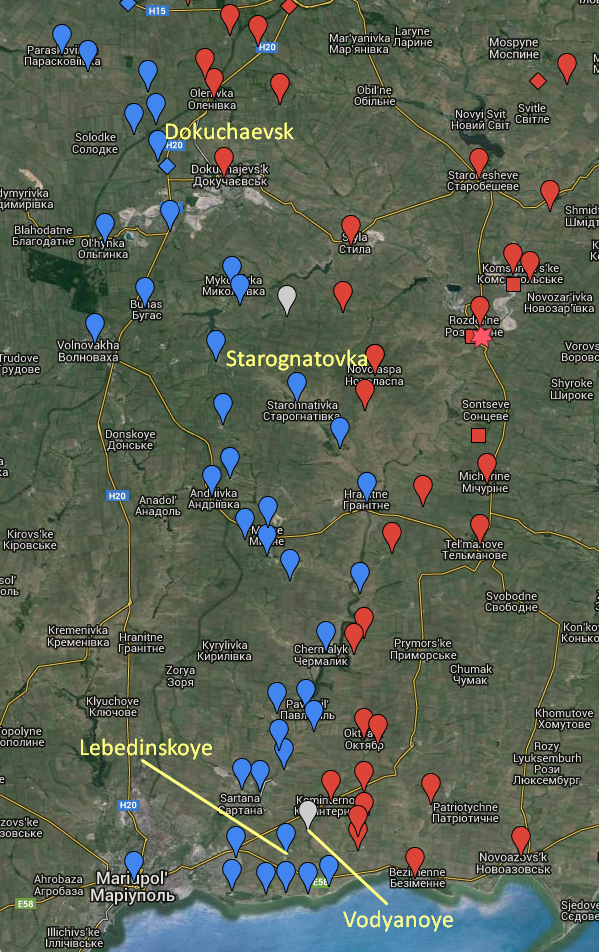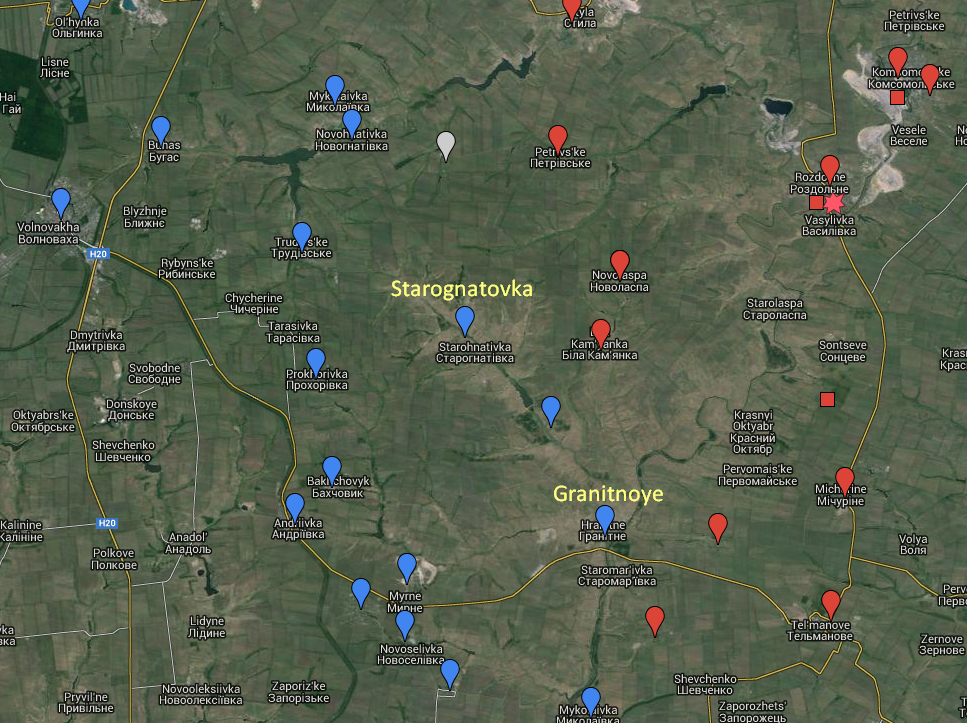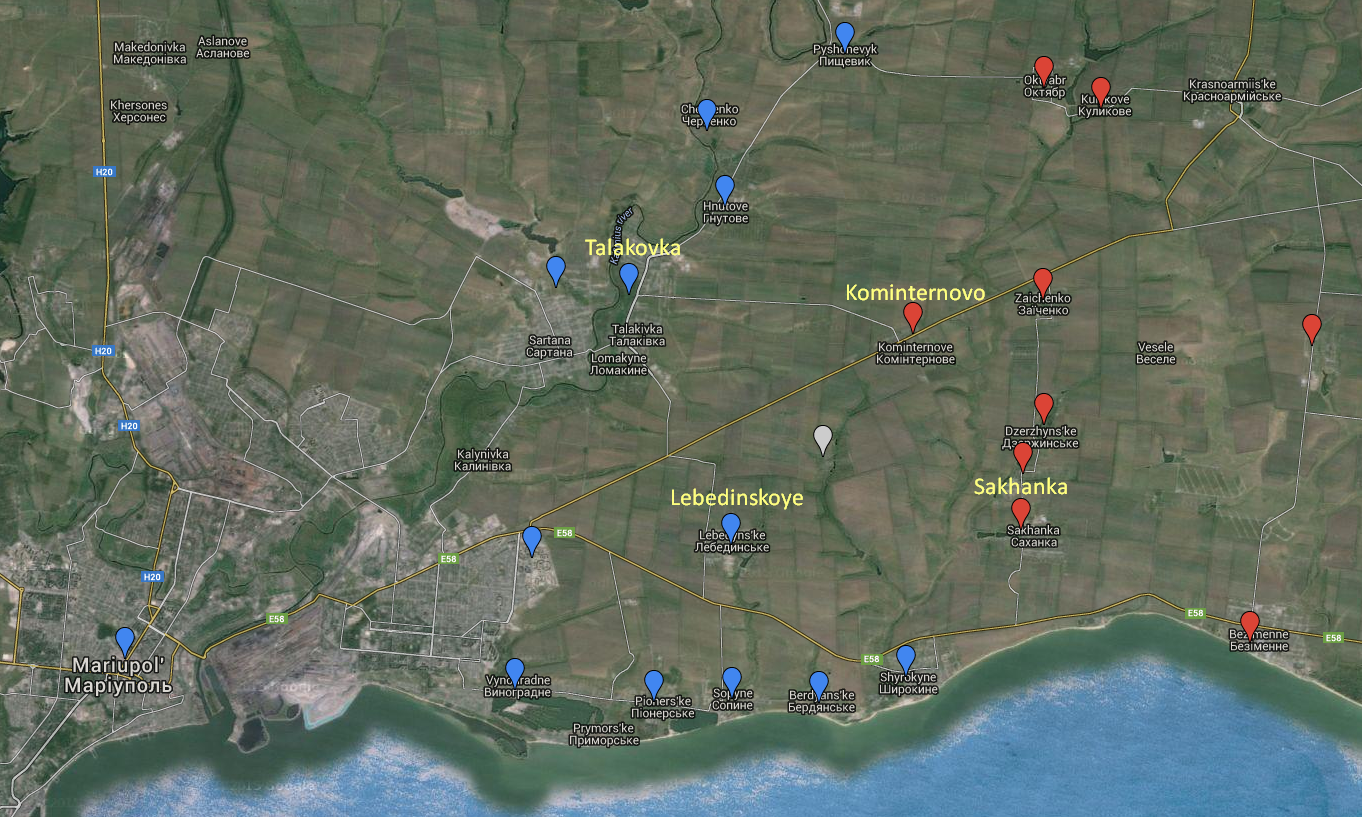Both sides report shelling in the Donetsk and Mariupol areas, with heavy fighting also seen around Gorlovka.
Yesterday’s live coverage of the Ukraine conflict can be found here.
Please help The Interpreter to continue providing this valuable information service by making a donation towards our costs.
For links to individual updates click on the timestamps.
For the latest summary of evidence surrounding the shooting down of flight MH17 see our separate article: How We Know Russia Shot Down MH17.
- READ OUR SPECIAL REPORT: An Invasion By Any Other Name: The Kremlin’s Dirty War in Ukraine
The Ukrainian military claims that Russian-backed fighters have continued attacks, using heavy weaponry, in both the Donetsk and Mariupol areas throughout the day.
Many of the locations attacked were also reportedly shelled last night.
On the Azov coast, Ukrainian troops stationed near Vodyanoye reported that Russian-backed fighters had used 120 mm mortars to shell positions outside Lebedinskoe.
Freelance journalist Paul Gogo confirmed that exchanges of fire were audible near Mariupol today:
Translation: Heard numerous machine gun shots, shooting and responses, from the village I passed through (north of Mariupol).
Further north, to the west of the river Kalmius, the ATO Press Centre claims that Ukrainian defensive positions near Starognatovka came under fire from infantry fighting vehicles, anti-aircraft artillery and grenade launchers.

Blasts were reportedly audible in separatist-held Dokuchaevsk, on the Donetsk-Mariupol highway north of Volnovakha:
Translation: #Dokuchaevsk several blasts from the direction of the new dam within the last hour.
To the north of Donetsk, Kiev reports grenade launcher and heavy machine gun attacks near Opytnoye and the Butovka mine.
West of the city, Ukrainian positions near Krasnogorovka were attacked with anti-tank weapons and shelled with mortars.
Meanwhile on the Artyomovsk-Debaltsevo highway, east of Gorlovka, a defensive position outside Luganskoye was reportedly attacked by an infantry fighting vehicle.
Local Twitter users have also reported fighting around Gorlovka:
Translation: #Gorlovka 6/7, Mayorsk battle. Loud.
Translation: #Gorlovka Fighting in Shirokaya Balka too. Loud…
The Ukrainian military claims that “on certain sections of the front” Ukrainian soldiers “were forced to open sanctioned, targeted fire” to put a stop to attacks.
— Pierre Vaux
Igor Girkin, former Russian intelligence officer and separatist paramilitary leader under the nom de guerre Strelkov, claims that he ordered the execution of at least four people while holding court in Slavyansk.
While speaking to Komsomolskaya Pravda‘s radio station on January 14, Girkin was asked how he had dealt with looting. He replied:
“With shootings. Because in war, especially under conditions of siege, all the trials… We ran a military court, and enacted legislation from 1941, introduced by Stalin.”
Girkin said that four people had been executed by shooting under his watch – two for looting amongst the troops, one for pillaging from the local population, and another for murder.
According to Girkin, the last man, who had killed a soldier, was an ideologically committed member of Ukraine’s ultra-nationalist Pravyi Sektor (Right Sector).
Back in August, 2014, Igor Druz, a senior adviser to Girkin, told the BBC that executions had been conducted “on several occasions” to “prevent chaos.”
Documents were also found after the liberation of Slavyansk by Ukrainian forces that appeared to be an order of execution signed by Girkin under the name of Igor Strelkov.
According to the documents, one Alexei Borisovich Pichko, a native of Slavyansk, had been sentenced to death under the law of 1941 for stealing trousers and two shirts from an abandoned home.

Soot-Stained Documents Reveal Firing Squad Executions in Ukraine
SLOVIANSK, Ukraine – At first glance, the carefully worded, soot-stained document adorned with an official stamp looks like a weathered decree from World War II. But dust it off and take a closer look and it becomes clear that it's an execution order.
But there was uncertainty as the either the authenticity of the documents, or the real commitment of the separatist to conducting executions.
That summer, the separatist commander of Gorlovka, Igor Bezler, had appeared in a video showing the apparent execution by firing squad of two men. The footage however, was suspect, given the lack of blood and the curious choice of camera angle, with no close-up on the bodies, as one is used to seeing with such videos, which are usually released by terror or paramilitary groups to instil fear.
Other separatist fighters have boasted of executions, most notably Sparta battalion commander Arsen Pavlov, known as Motorola, who reportedly told the Kyiv Post by phone that he had shot 15 Ukrainian prisoners dead.
This story was repeated by former prisoners, who said that Pavlov had murdered Ihor Branovytsky, a wounded Ukrainian POW, just before he was due to be returned in an ambulance during a prisoner exchange.
— Pierre Vaux
Suspicious malware has been found on computers at Kiev’s Boryspil Airport, software that appears to be similar to that which shut down several Ukrainian power plants in December which was traced back to Russia. The Independent reports:
Speaking to Reuters, military spokesman Andriy Lysenko said: “The control centre of the server, where the attacks originate, is in Russia.”
The malware found at the airport was similar to that which targeted three major Ukrainian power firms in late December, in an attack which caused blackouts and power outages across the country.
This attack was also traced back to Moscow, after a US cyberintelligence firm found it was part of a Russian group’s ongoing hacking campaign.
Reuters reports that the Ukrainian government is reviewing security procedures and preparing for more cyber attacks:
“In connection with the case in Boryspil, the ministry intends to initiate a review of anti-virus databases in the companies which are under the responsibility of the ministry,” said Irina Kustovska, a spokeswoman for Ukraine’s infrastructure ministry, which oversees airports, railways and ports.
Ukraine’s state-run Computer Emergency Response Team (CERT-UA) issued a warning on Monday of the threat of more attacks.
…
A spokeswoman for the airport said Ukrainian authorities were investigating whether the malware was connected to a malicious software platform known as “BlackEnergy”, which has been linked to other recent cyber attacks on Ukraine. There are some signs that the attacks are linked, she said.
Last month’s attack on three Ukrainian power plants is considered by many experts to be a “watershed” moment because it is the first known time that infrastructure has been successfully brought down by a cyber attack. The US and other countries vowed to increase their own security procedures because of the severity of the attack.
Others are warning that Russia’s hacking capabilities have been underestimated. Josh Cohen writes in Intersection:
While the commander of U.S. Army units in Europe, Lt. General Ben Hodges, calls Russia’s electronic warfare capabilities “eye-watering,” Russia’s cyber warfare capabilities are the Kremlin’s ultimate asymmetric tool. While Chinese hackers receive the majority of attention, the United States’ Director of National Intelligence James Clapper believes Russia’s cyber threat exceeds the Chinese one, using stealthier and more advanced cyberattack methods.
The Russian military recently established a dedicated cyber command in preparation for a future conflict, and reportedly hacked both the State Department and the White House. Although the Russian cyber penetration explored only unclassified portions of the White House network, the attackers were still able to gain access to the President’s daily schedule.
Moreover, this represents just the tip of the iceberg. Far more worryingly, Russian hackers have also been actively exploring the United States’ infrastructure vulnerabilities. In recent Congressional testimony, Clapper revealed that Russian hackers had successfully penetrated the industrial control systems which monitor and access critical U.S. infrastructure such as water and energy systems. By remotely accessing these systems, hackers could theoretically take down the United States’ power grid.
— James Miller
For the first time in the trial of Nadezhda Savchenko, a Ukrainian serviceman has been allowed to give evidence in court.
Savchenko’s defence team introduced Ivan Rusnak, a soldier in the 80th Air Mobile Brigade, who was with Savchenko just before her capture by separatist fighters in June, 2014.
Translation: Defence witness in Nadezhda Savchenko’s case – soldier in the 80th Air Mobile Brigade of the Ukrainian Armed Forces, Ivan Rusnak
Savchenko herself has now been on hunger strike for a month today.
Mark Feygin, another of her lawyers, reported on his Instagram page today that Savchenko had lost 15 kilogrammes in weight:

Сегодня ровно месяц голодовки Надежды Савченко. Так она сейчас выглядит. Минус 15 кг
"Сегодня ровно месяц голодовки Надежды Савченко. Так она сейчас выглядит. Минус 15 кг"
Witness Rusnak tells [the court] about the circumstances on 17/06/14, how the separatists knocked out their BTR [Armoured Personnel Carrier], how they were burning inside it.
Witness Rusnak says that after their BTR had been knocked out, they took up defensive positions and began to to withdraw. At this moment Savchenko came across them.
Rusnak says that Nadezhda didn’t have a rucksack with binoculars and a radio on her, but a tactical vest with medical kits, with which she provided first aid
Separatist fighters, giving testimony for the prosecution, have claimed that Savchenko was wearing a rucksack when captured. According to the prosecution, she was acting as an artillery spotter. This is key to the case as she is charged with directing mortar fire at a group of Russian reporters.
Rusnak: at approximately 9:40 Savchenko was talking on her phone, she was shot at from the bushes, she fell, crawled over to us and bandaged her hand.
Witness Rusnak charts a diagram of the events at the scene: where the BTR was hit, where they withdrew to, where they met. Savchenko.
Witness Rusnak did not see or hear that Savchenko was correcting artillery fire.
Savchenko is a military officer (and now MP) who was captured by separatist fighters near Lugansk in June, 2014. She was subsequently taken across the border to Russia where she has been jailed and charged with the murder of two Russian journalists, Igor Kornelyuk and Anton Voloshin, during a mortar attack on a checkpoint.
— Pierre Vaux
The Ukrainian military claimed this morning that Russian-backed forces had conducted 48 attacks within the previous 24 hours, using mortars, grenade launchers, infantry fighting vehicles and small arms.
Colonel Andriy Lysenko, military spokesman for the Presidential Administration, has announced that one Ukrainian soldier was wounded in combat, as well as two others injured by explosive devices.
According to the ATO Press Centre report as of 6:00 today, the most intense fighting was seen in the Gorlovka area, with grenade launcher and small-arms attacks on Ukrainian defensive positions near Mayorsk, Zaytsevo, Novgorodskoye and Luganskoye.
In the south of the Donetsk region, the military reports that a BMP (infantry fighting vehicle) fired on Ukrainian positions near the village of Starognatovka, east of Volnovakha.
The admin of a VKontakte page for residents of the nearby village of Granitnoye also reported attacks yesterday, claiming that the village had been fired on with “small arms and something heavier.”

On the coast, Colonel Lysenko reported attacks on positions near the villages of Talakovka and Lebedinskoye, just outside Mariupol:
In this same area, 0629.com.ua reports that several shells struck the separatist-held village of Kominternovo, around 10 kilometres outside Mariupol.
An unnamed OSCE source was quoted by 0629 as saying that a civilian received light wounds during the shelling yesterday afternoon. They have been taken to a hospital in separatist-held Novoazovsk.
Oleksandr Kindsfater, spokesman for the Ukrainian military headquarters in Mariupol, told 0629 that Russian-backed fighters had shelled the village by accident.
According to Kindsfater, Russian-backed fighters in Sakhanka, southeast of Kominternovo, used 82 mm mortars to bombard Ukrainian marines’ positions outside Kominternovo, but several of the rounds fell short and struck the village itself.

However the separatist head of the Novoazovsk district administration, Oleg Morgun, blames the Ukrainian military for the shelling.
In Donetsk, the separatist-backed city administration claims today that Ukrainian forces have shelled the Donetsk-Severny station in the Kievsky district. As a result of the shelling, a heating main has been damaged.
— Pierre Vaux